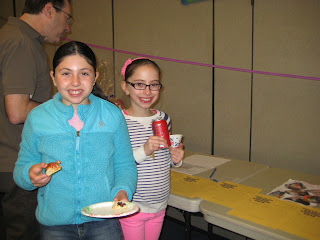Our Edot students are getting ready for Purim, which is this coming Sunday. We briefly reviewed the original Purim story, as told in the Book of Esther. Amazingly, the Rabbis who determined which books to include in the Hebrew Bible and which to leave out, decided to include the Book of Esther, even though it is the only book not to mention the name of God even once or to take place even partially in the Land of Israel. On top of that, the names of the heroes in the story are those of Babylonian gods - Marduk (Mordechai) was the Chief God of the Babylonian pantheon, and his consort was Astarte (Esther). Why, then, include this book in the Bible? The Rabbis recognized important Jewish values within the story, which overrode the other issues mentioned above - values such as Jews being responsible for each other, tz'daka (helping the needy in the community), putting faith in an unseen God (who is in the story though his Name is not mentioned, according to the Rabbis), and the willingness to risk one's life for one's people.
Once I was sure that all the students were familiar with the major elements of the story, I introduced a historical aspect to the holiday - special Purims. Though the original story in the Bible very likely never took place as written, according to Biblical scholars and historians, there were hundreds of Jewish communities over the past 2,500 years or so, scattered over the globe, which could historically document being seemingly miraculously saved at the very last minute from certain destruction. I shared the story of one of these communities - Fossano in Italy in the year 1797, when, on the 4th day of Pesach, Christians entered the Jewish ghetto with the intent of looting Jewish homes and shops, and killing its inhabitants. Just as they entered the synagogue where the Jews had all gathered awaiting their end, a French cannonball (Napoleon's army had laid siege to the city some weeks before) crashed into the vestibule of the synagogue, just in front of the Christian mob. It didn't explode, but scared off the mob and saved the Jews just at the moment they were about to meet their end. Napoleon succeeded in capturing the city two days later, and assigned many of his soldiers to protect the Jewish ghetto. To this day, if you visit Fossano (in the foothills of the Alps, on the Austrian border), you will see how the community commemorated this "special Purim" by creating a window out of the hole in the wall created by the cannonball, with the Hebrew inscription in gold above the window, "Saved by the Miracle of the Bomb."
I then assigned different groups of students a Special Purim. Each group received a folder containing the story of their assigned special Purim, along with information about how the holiday of Purim is celebrated in different Jewish communities around the world. Some stories included how the special Purim is celebrated each year by the community, but where this information was not included, the children could refer to the information provided about the country in which their assigned special Purim took place, to show how it was likely celebrated. Each group was asked to create a poster depicting what the miracle was that saved the community, and how it is celebrated each year.
 |
| One of the Special Purim folders (this one took place in the 17th century in the Frankfurt, Germany ghetto) |
|
 |
| The story of the Purim of Fettmilch |
 |
| Information packet about Purim Customs around the World |
Purim is a fun and certainly a colorful holiday, and hopefully this poster activity put the students in the mood for the upcoming Purim Carnival that our Teens in LAFTY will be putting on this Sunday. The finished posters have been hung on the hallway bulletin board just outside Room 202; we hope you can come and see them, even after the holiday is over. In the meantime, enjoy these photos of Edot students in action.
 |
Designing the "Miracle of the Bomb" poster
|
 |
| Writing the summary of the miracle for the poster |
 |
| Working on the Purim of Saragossa, Spain (13th century) poster |
 |
| Purim Taka (Hebron, 16th century) |
 |
| Curtain Purim (Prague, early 17th century) |
 |
| Getting all the paint colors organized (it's fascinating to watch how each group organizes itself and plans how to complete the project in the short amount of time they're given) |
 |
| I'm not kidding about how little time we have - the time allotted for the poster work was from 4:30 to 4:50 and again from 5:35 to 6:00 - just 45 minutes, and that included cleanup! |
 |
| Our Edot students are definitely focused on their tasks |

































































